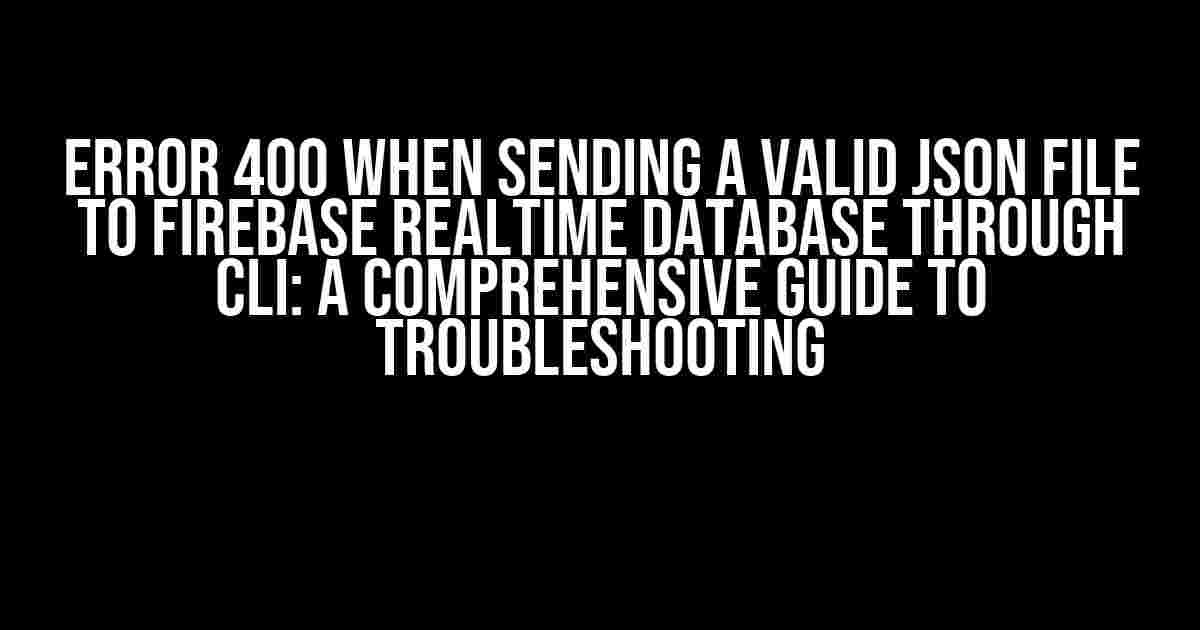Are you tired of banging your head against the wall, trying to figure out why Firebase Realtime Database is rejecting your perfectly valid JSON file? You’re not alone! The dreaded Error 400 has plagued many a developer, leaving them frustrated and confused. Fear not, dear reader, for we’re about to embark on a journey to diagnose and conquer this pesky error once and for all.
What is Error 400?
Error 400, also known as a “Bad Request” error, is an HTTP status code that indicates the request sent to the server is invalid or cannot be processed. In the context of Firebase Realtime Database, this error typically occurs when trying to upload a JSON file using the Firebase CLI. But don’t worry, we’ll get to the bottom of this!
Preparing for Battle: Gathering Information
Before we dive into the troubleshooting process, let’s gather some essential information to help us tackle the problem. Please have the following ready:
-
firebase.jsonfile: This file contains the configuration for your Firebase project. -
JSON fileyou’re trying to upload: Make sure it’s a valid JSON file with the correct structure and data. -
Firebase CLI version: Check your Firebase CLI version by runningfirebase --versionin your terminal. -
Project permissions: Ensure you have the necessary permissions to write to your Firebase Realtime Database.
Troubleshooting Steps
Now that we have our arsenal of information, let’s work through the troubleshooting steps:
Step 1: Verify JSON File Structure and Content
The first potential culprit is the JSON file itself. Double-check that:
- The JSON file is correctly formatted, with no syntax errors.
- The file contains the expected data structure and keys.
- You’re not exceeding the maximum allowed size for a single write operation (10MB).
Take a closer look at your JSON file and ensure it adheres to the Firebase Realtime Database data structure guidelines. You can use online JSON validators or tools like jq to parse and verify your JSON file.
<your-json-file> | jq .
Step 2: Check Firebase CLI Configuration
Next, let’s examine the Firebase CLI configuration:
-
Verify that your
firebase.jsonfile is correctly configured and points to the correct Realtime Database instance. - Ensure the CLI is authenticated and authorized to write to your Realtime Database.
You can check your Firebase CLI configuration by running:
firebase config:get
Step 3: Validate Project Permissions
Permission issues can also lead to the Error 400. Double-check that:
- Your Firebase project has the necessary permissions to write to the Realtime Database.
- The Firebase CLI is authenticated with the correct credentials.
Review your Firebase project’s IAM permissions and ensure the necessary roles are assigned. You can do this via the Firebase Console or using the Firebase CLI:
firebase projects:get-iam-policy <PROJECT_ID>
Step 4: Inspect the Error Message
Parsing the error message can provide valuable insights into the issue:
- Check the error message for specific details about the problem.
- Look for any clues about the request that’s causing the error.
A closer examination of the error message might reveal the root cause of the issue.
Step 5: Try a Different Upload Method
Sometimes, the issue lies with the upload method itself. Try:
- Using the Firebase Console to upload the JSON file manually.
-
Employing a different CLI command, such as
firebase database:pushinstead offirebase database:set.
This can help isolate the problem and provide a workaround.
Common Pitfalls and Solutions
Here are some common culprits that might cause the Error 400:
| Pitfall | Solution |
|---|---|
| Invalid JSON file structure | Verify the JSON file adheres to the Firebase Realtime Database data structure guidelines. |
| Firebase CLI misconfiguration | Check the firebase.json file and CLI configuration. |
| Permission issues | Review Firebase project permissions and ensure the necessary roles are assigned. |
| Large JSON file size | Split the JSON file into smaller chunks or use a streaming upload method. |
Conclusion
Error 400 when sending a valid JSON file to Firebase Realtime Database through CLI can be a frustrating experience. However, by methodically working through the troubleshooting steps outlined above, you should be able to identify and resolve the underlying issue. Remember to:
- Verify the JSON file structure and content.
- Check the Firebase CLI configuration and permissions.
- Inspect the error message for clues.
- Try alternative upload methods.
By following this comprehensive guide, you’ll be well on your way to conquering the Error 400 and successfully uploading your JSON file to Firebase Realtime Database using the CLI.
Happy debugging!
Frequently Asked Question
Got stuck with Error 400 when sending a valid JSON file to Firebase Realtime Database through CLI? Don’t worry, we’ve got you covered!
Q1: What does Error 400 mean when sending a JSON file to Firebase Realtime Database?
Aha! Error 400 is a bad request error, which means there’s something wrong with your request. It could be a syntax error in your JSON file, invalid data, or even a permissions issue. Check your JSON file and request for any mistakes!
Q2: How do I check my JSON file for syntax errors?
Easy peasy! You can use online tools like JSONLint or JSLint to validate your JSON file. These tools will highlight any syntax errors, so you can fix them and try again. You can also use the `firebase realtime:write` command with the `– verbose` flag to get more detailed error messages.
Q3: What are the common JSON syntax errors that cause Error 400?
Ouch! Common JSON syntax errors include missing or mismatched brackets, incorrect nesting, and invalid data types. Also, make sure your JSON file is UTF-8 encoded and doesn’t contain any BOM (Byte Order Mark) characters. Double-check your JSON file for any of these errors!
Q4: Can I use the Firebase CLI to debug my request?
Absolutely! The Firebase CLI provides a `– debug` flag that enables debug logging. This will give you more detailed error messages and help you identify the issue. You can also use the `firebase realistic:write` command with the `– verbose` flag to get more information about the request.
Q5: What if I’m still stuck with Error 400 after checking everything?
Don’t worry! If you’ve checked everything and still can’t get rid of Error 400, try reaching out to the Firebase support team or searching the Firebase community forum for similar issues. You can also provide more details about your request and JSON file, and we’ll do our best to help you troubleshoot the issue!




